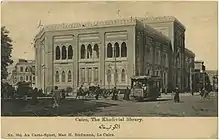Egyptian National Library and Archives
| Egyptian National Library and Archives دار الكتب والوثائق القومية | |
|---|---|
 | |
| Location | Cairo, Egypt |
| Type | Public, National library and National archives. |
| Established | 1870 |
| Other information | |
| Director | Ludwig Stern, Wilhelm Spitta, Ali al-Biblawi, Murad Mukhtar, Karl Vollers, Bernhard Moritz, Muhammad Ali Biblawi, Arthur Schaade, Muhammad Ali Biblawi, Ahmed Lutfi el-Sayed, Ahmed Sadiq Bey, Abd al-Hamid Abu Hayf |
| Website | http://www.darelkotob.gov.eg |
The Egyptian National Library and Archives (Arabic: دار الكتب والوثائق القومية; "Dar el-Kotob") is located in Nile Corniche, Cairo and is the largest library in Egypt, followed by Al-Azhar University and the Bibliotheca Alexandrina (New Library of Alexandria). The Egyptian National Library and Archives are a non-profit government organization.[1]
The National Library houses several million volumes on a wide range of topics.[1] It is one of the largest in the world with thousands of ancient collections. It contains a vast variety of Arabic-language and other Eastern manuscripts, the oldest in the world.[1] The main library is a seven-story building in Ramlet Boulaq, a district of Cairo. The Egyptian National Archives are contained in an annex beside the building.
The National Archives, located in an annex beside the library, houses a vast and diverse collection. The holdings are particularly significant to those who work on Egyptian social and political history, although it is not open to the public.
History

The Egyptian National Library was proposed by minister Ali Pasha Mubarak, minister of public works, to Khedive Ismail in 1870. The library, which was known then as Khedivial Kutub Khana, was first located at the ground floor of Prince Mustafa Fadel's palace in Darb Al Gamamiz.
In 1889, the library was moved to the Salamlek of the same palace. Later, Khedive Tawfiq ordered a new facility to host the growing collection, but this was not accomplished until the time of Khedive Abbas Helmy II. In 1904 a new building in Bab Al Khalq opened its doors to the public housing both the National Library and the Museum of Islamic Art.
In the 1970s, a newer building was built on the Corniche, with an adjacent one for the archives, but Bab Al Khalq Library is still functioning and houses a museum.[2]

On Friday, January 24, 2014, a car bomb meant to destroy the Police Headquarters across the street from the National Library and Archives did quite a bit of damage to the library's building and collections. National Library and Archive head Abdul Nasser Hassan estimated that the losses would be around $2.81 million in repairs.[3] Lighting and ventilation systems were destroyed and the Neo-Mamluk architectural facade was heavily damaged. Showcases and displays containing irreplaceable ancient manuscripts and papyri within the library's museum exhibition area were damaged along with all the furniture in the building. The conservation staff at the National Library and Archive's were able to save the documents on display, although they did sustain some damage.[4]
Contents
Collections include a wide variety of manuscripts of the Qur'an, written on paper and parchment. Some of which date back to early Kufic script. Others are written by celebrated calligraphers. Of Egyptian Islamic materials, there is perhaps the outstanding collection of illuminated manuscripts of the Qur'an in the Mamluk text-hand, and in Trilinear and Rayhani hands. There are also collections of Arabic papyri from different sites in Egypt, some dating to the 7th century AD or earlier. The library is a mine of information on early Islamic Egypt's social and cultural life. Ancient Persian and Ottoman documents are also part of the collection.

The library remains Egypt's largest resource of manuscripts and documents that include more than 57,000 of the most valuable manuscripts in the world. The manuscript collection covers a vast number of subjects, fully documented, dated, and compiled. It also houses a rare number of Arabic papyri. These are related to marriage, rent, and exchange contracts, as well as records, accounts of taxes, distribution of inheritance, etc. The oldest papyrus group dates back to the year AH 87 (AD 705); only 444 papyri from this collection were published.
The library also has a large collection of medieval Arabic coins from as early as AD 696, which were published by Stanley Lane-Poole, Bernhardt Moritz and recently by Norman D. Nicol, Jere L. Bacharach and Rifa'at al-Nabarawy in 1982. These collections are of high archeological value.[5]
Collections formed by Ahmed Taymour Pasha, Ahmed Zaki Pasha, Ahmed Tal'aat Bey and Mustafa Fadel all came to the National Library in the early 20th century.
See also
References
- "The National Library and Archives". www.cairo.gov.eg. Retrieved 2018-11-05.
- السيد, أيمن فؤاد (2010). كنوز دار الكتب المصرية. Cairo: دار الكتب والوثائق القومية، جمعية المكنز الإسلامي. pp. 9, 10, 11, 12.
- "Bomb damages Egypt's National Library and Archives - Islamic - Heritage - Ahram Online". english.ahram.org.eg. Retrieved 2018-11-18.
- "Preserving treasures in Cairo's National Library and Archives". Anita Chowdry. 2014-01-27. Retrieved 2018-11-18.
- "دار الكتب والوثائق القومية". www.darelkotob.gov.eg. Retrieved 2018-11-18.
Catalogues
- Moritz, Bernhardt: "Additions à la collection numismatique de la Bibliothèque Khédiviale". In: Bulletin de l'Institut Egyptien; 4e sér. 4 (1903), pp. 199–204.
- Nicol, Norman D.; el-Nabarawy, R. & Bacharach, J. L.: Catalog of the Islamic Coins, Glass Weights, Dies and Medals in the Egyptian National Library, Cairo. Malibu, California 1983.
Bibliography
- Marcel Lajeunesse, ed. (2008). "Égypte". Les Bibliothèques nationales de la francophonie (PDF) (in French) (3rd ed.). Bibliothèque et Archives nationales du Québec. OCLC 401164333.

- "Egypt", World Report 2010, The Hague: International Federation of Library Associations, OCLC 225182140,
Freedom of access to information
(Includes information about the national library)
External links
- Official website (in English and Arabic)
- Museum of the National Library of Egypt Official Facebook page for the library's museum space.